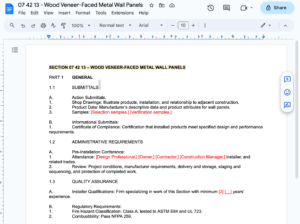Simplifying Product Substitution Requirements for Everyone
Product substitutions can be a confusing topic for many in the construction industry, including Design Professionals (DPs). Manufacturers often lack a deep understanding of how to specify product substitution requirements, and DPs may find it challenging to navigate this process. To clear the air and demystify the subject, let’s start by defining what product substitutions are:
Understanding Product Substitutions
Product substitutions, in construction lingo, refer to the approval of materials, products, or equipment by DPs for use instead of those initially specified in the project documents. These substitutions can come into play during the bidding and construction phases of a project. To effectively manage substitutions and ensure clarity, it’s crucial to establish clear procedural requirements for them in the Project Manual, a document prepared by the DP.
First, it’s essential to differentiate between substitutions and alternates. An “alternate” or “alternate bid” is a formal request within a bid to add or deduct an amount from the base bid if a corresponding change in the work is accepted. In contrast, substitutions involve replacing specified materials or products with alternatives.
Specifying Product Substitution Requirements
Many construction projects use standardized documents, such as those prepared by the American Institute of Architects (AIA). These documents offer guidance on handling substitutions. Let’s explore what AIA documents have to say about substitutions:
AIA A701-2018 – Instructions to Bidders:
The 2018 edition of AIA A701 provides improved coverage of substitutions compared to earlier versions. Here’s a breakdown:
- Article 3 – Bidding Documents:
- Substitutions are defined as materials, products, or equipment approved by DPs to meet specified standards.
- The term “brand name or equal” does not limit competition.
- Substitution Process:
- Written substitution requests must reach the Architect at least ten days before the bid receipt date.
- Bidders should use a Substitution Request Form if provided in the Bidding Documents.
- If no form is provided, requests should include product details, reasons for substitution, relevant data, and the impact on other parts of the project.
- Requests for substitutions should be submitted before bid receipt, and any subsequent changes must include the impact on other aspects of the project.
- Decision and Approval:
- The burden of proving the merit of a proposed substitution falls on the proposer.
- The Architect’s decision is final.
- Approvals are documented in an Addendum.
- No substitutions are considered after contract award, unless specified in the Contract Documents.
Considerations with the Use of AIA A701-2018:
AIA Document A201 states that the Instructions to Bidders are not part of the Contract Documents, and therefore not applicable after contract award. Some projects may want to allow substitutions even after the award. In such cases, DPs should include substitution procedures in Division 01 – General Requirements.
AIA A201-2017 – General Conditions of the Contract for Construction:
This document has minimal content regarding substitutions:
- Article 3 – Contractor:
- Substitutions are permitted with Owner consent, after evaluation by the Architect and with a Change Order or Construction Change Directive.
- Article 7 – Changes in the Work:
- Substitutions can be part of a change if they involve additions, credits, or related Work.
Reasons for Considering Substitutions
Why even entertain the idea of substitutions when you’ve carefully selected the products you want? Here are some perspectives:
- Open and Competitive Bidding: Allowing substitutions can encourage open and competitive bidding, which can lead to lower prices.
- Contractor Experience: Contractors may have valid reasons, based on their experience, to consider products other than those specified.
- Availability Issues: Specified products might become unavailable due to various reasons, such as production discontinuation or delays.
The Concerns About Accepting Substitutions
While substitutions can offer benefits, they also raise concerns:
- Quality and Suitability: There’s the potential for the use of inferior or inappropriate products.
- Evaluation Time: Evaluating substitution requests can be time-consuming and costly.
- Extended Bidding Process: Allowing substitutions may lead to a longer bidding process.
- Loss of Control: Using unfamiliar products may lead to a loss of control over the project.
Incorporating Substitution Procedures
To effectively handle substitutions, Project Manuals should include specific guidance:
- Section 01 20 00 – Price and Payment Procedures: Cover general substitution procedures applicable to all other divisions.
- Individual Sections: Each section listing manufacturers should indicate whether substitutions are allowed or not.
Timing of Substitutions
Substitutions can be considered at different stages:
- During Bidding: Qualified bidders can submit written substitution requests, which may be evaluated along with bids.
- Prior to Construction: Substitutions can be considered before contract execution.
- During Construction: Some substitutions may be considered within a defined period after contract award.
How Products are Specified
Understanding how products are specified helps determine when substitutions are needed:
- Reference Standard Specification: Products must meet specified requirements, and no substitution requests are necessary.
- Descriptive Specification: Specific attributes are described, and substitutions must conform to these attributes.
- Performance Specification: End results are specified, and substitutions must meet those results.
- Proprietary Specification: Specific manufacturers and products are named, and substitutions may be considered as outlined in the Project Manual.
Open vs. Closed Specifications
Publicly funded projects usually don’t permit closed specifications by law. In privately funded projects, closed specifications are allowed but not preferred due to potential price inflation.
Product Substitution Terminology
Different terms indicate how substitutions are handled:
- “Or Equal”: Allows substitutions if the Contractor defines them as “equal.”
- “Or Approved Equal”: Requires review and approval by the Architect/Engineer.
- “Or Approved Substitute”: Implies review and approval and allows for the use of non-“equal” but acceptable products.
Considerations in Evaluating Substitutions
When evaluating substitutions, consider factors like function, appearance, quality, dimensions, longevity, code compliance, manufacturer history, and warranty terms.
Conclusion: Navigating the Substitution Process
Understanding the complexities of product substitutions is essential for everyone involved in construction projects. It helps to manage expectations, ensure compliance, and, at times, discover cost-saving opportunities. Effective management of the substitution process, clear specifications, and diligent evaluation are key to successful project execution. With this knowledge, you can confidently navigate the intricacies of product substitutions in the construction industry.
Related SimpleSpecs Specification Templates:
- 01 20 00 – Price and Payment Procedures: Includes general requirements for product substitutions.
- 01 25 19 – Substitution Request Form: For incorporation into a Project Manual to provide a format for product substitutions.



